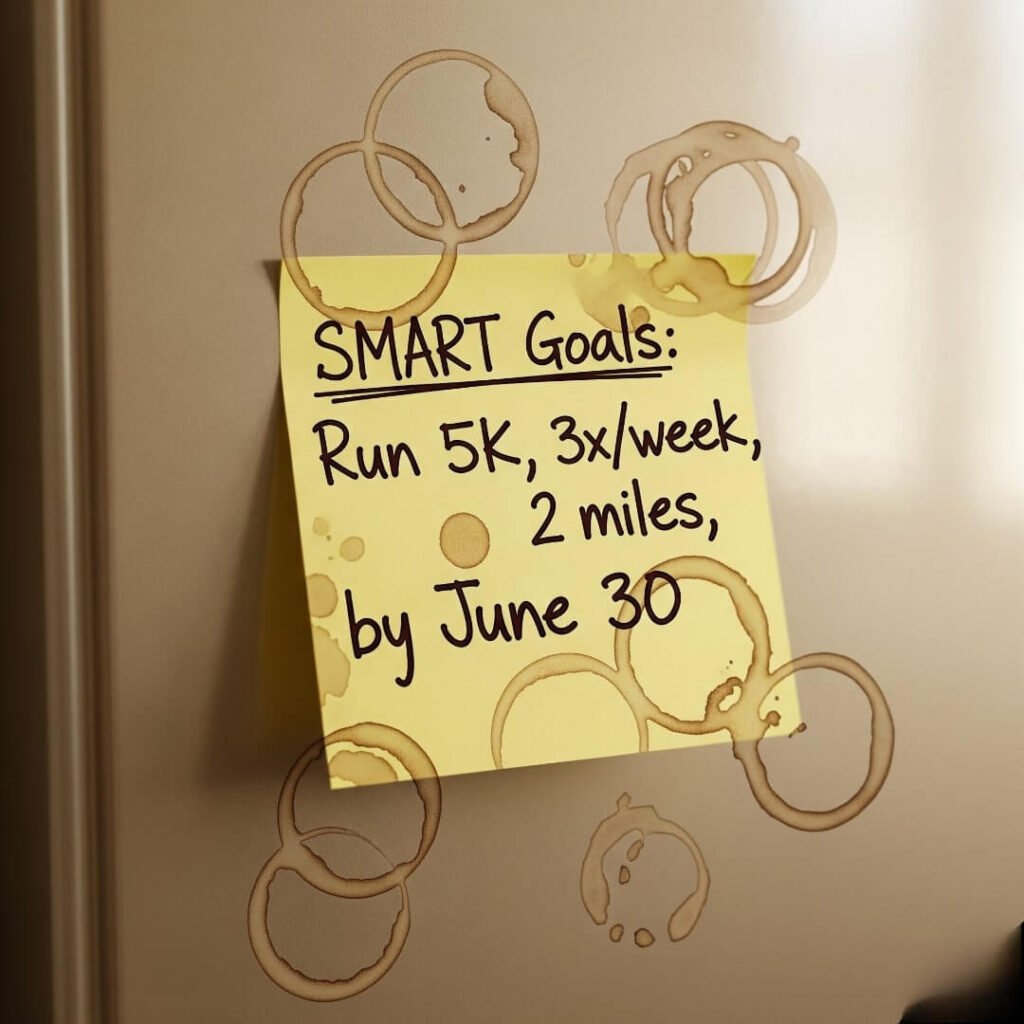I’m sitting here in my tiny Chicago apartment, coffee gone cold, staring at a notebook where “SMART goals explained” is scribbled like it’s gonna save my life. Seriously, I’m a mess when it comes to goal setting—like, my brain’s a Pinterest board of half-baked dreams, and I’ve got the attention span of a TikTok scroll. But SMART goals? They’re the real deal, and I’m gonna walk you through how I, a deeply flawed human, figured out how to make them stick. Picture me last week, sprawled on my couch with Cheeto dust on my fingers, trying to “visualize success” while my cat glares at me. Let’s just say, it’s been a journey. Here’s my raw, unfiltered take on SMART goals explained, with all my screw-ups and aha moments.
What Are SMART Goals, Anyway?
Okay, so SMART goals explained in a nutshell: it’s an acronym—Specific, Measurable, Achievable, Relevant, Time-bound. Sounds like corporate jargon, right? I thought so too when I first heard it at a work seminar in Denver last year, doodling in my notebook instead of listening. But here’s the thing: it’s like a cheat code for not sucking at life. Instead of vague nonsense like “get fit,” you make goals that don’t let you wiggle out of them. I learned this the hard way after promising myself I’d “be healthier” in 2024, only to end up eating tacos at 2 a.m. on New Year’s Day.
- Specific: Nail down exactly what you want. Not “be fit,” but “run a 5K without dying.”
- Measurable: Track it. Like, “I’ll run 3 times a week, 2 miles each.”
- Achievable: Be real. I’m not Usain Bolt; a 5K by June is my speed.
- Relevant: Does it matter to you? Running makes me feel alive, not just sweaty.
- Time-bound: Set a deadline. June 30th, or I’m just dreaming again.

My First SMART Goal Fail (and What I Learned)
Last spring, I decided I’d “learn Spanish fluently” because I was obsessed with Bad Bunny and thought, why not? Spoiler: I crashed and burned. My goal was vague as hell—“fluent” could mean anything from ordering tacos to debating philosophy. I didn’t track progress, so I’d study Duolingo for three days, then ghost it for weeks. It wasn’t achievable (I work 50 hours a week, dude), and honestly, it wasn’t that relevant—I just wanted to seem cool. No deadline either, so I drifted. SMART goals explained why this flopped: I broke every rule.
But here’s where it gets real. Failing at Spanish stung, but it taught me to break things down. So, I tried again with a SMART goal: “Learn 50 Spanish phrases for travel by July 1st, practicing 15 minutes daily.” I used an app to track it, and it was doable with my schedule. By June, I could order coffee in Spanish at a café in Pilsen without sweating bullets. Progress, yo!
For more on why vague goals tank, check out this Forbes article on goal setting. It’s legit.
How I’m Using SMART Goals Explained to Crush It (Sorta)
Fast forward to now, I’m using SMART goals to tackle running that 5K. I’m not a runner—my legs are like, “Why do you hate us?” But I set a specific goal: “Run a 5K in under 35 minutes by June 30th.” Measurable? I use a running app to log miles. Achievable? I started with 1-mile jogs, not marathons. Relevant? Running clears my head after staring at spreadsheets all day. Time-bound? June 30th is circled in red on my fridge calendar.

Here’s the embarrassing part: I missed a week of runs because I binged Squid Game instead. Like, priorities, right? But the SMART framework keeps me honest. I can see exactly where I’m slacking (Measurable, yo), and the deadline looms like my mom’s disappointed face. It’s not perfect, but it’s working.
Tips for Making SMART Goals Stick (From a Hot Mess)
I’m no guru, but here’s what I’ve learned from my chaotic attempts at SMART goals explained:
- Start stupid small: My first running goal was “jog 10 minutes without cursing.” It felt dumb, but it built momentum.
- Track it like a stalker: Use an app, a notebook, whatever. I scribble my runs in a dollar-store journal.
- Tell someone: I told my buddy Jake about my 5K goal, and now he texts me, “You running or napping?” Rude, but effective.
- Forgive your screw-ups: I skipped runs, ate too many donuts. It’s fine. Just get back to it.
- Tweak as you go: My original 5K goal was April, but life happened. June’s more realistic.
For extra tips, this Harvard Business Review piece on goal setting has some solid advice, even if it’s fancier than my vibe.
Why SMART Goals Explained Feels Like a Lifeline
Here’s the raw truth: I’m 29, living in a overpriced one-bedroom, and sometimes I feel like I’m failing at adulting. My desk is a war zone of Post-its and empty LaCroix cans, and my cat’s judging me harder than my boss. But SMART goals explained gives me a way to claw out of the chaos. It’s not about being perfect—it’s about making progress that feels like me. Like, I ran 2 miles yesterday, and yeah, I wheezed like a broken accordion, but I did it. That’s the power of SMART goals: they turn your messy dreams into something you can actually grip.

Wrapping Up This Chaotic Chat
So, that’s my take on SMART goals explained—my messy, human attempt at making goals that don’t flop. I’m still figuring it out, tripping over my own shoelaces, but it’s working. If I can do it, you can too. Try setting one tiny SMART goal today—something specific, trackable, doable, meaningful, with a deadline. Share it with a friend, or hell, DM me on X (@RandomChicagoMess, lol). Let’s hold each other accountable, yeah?



























